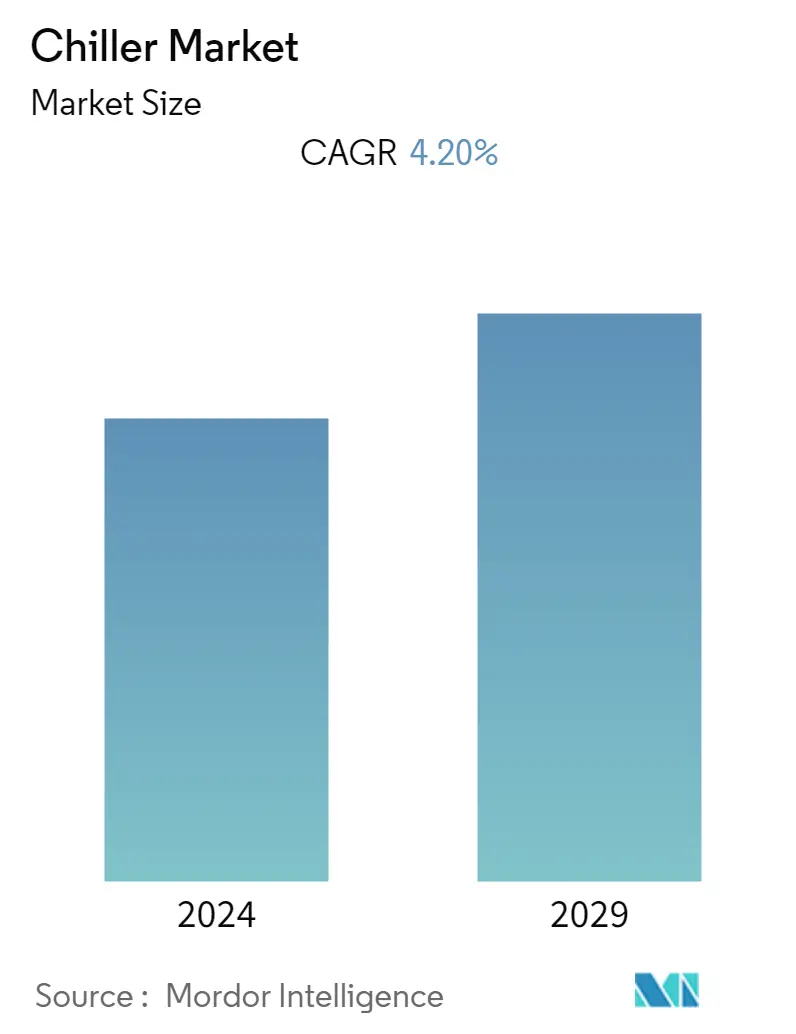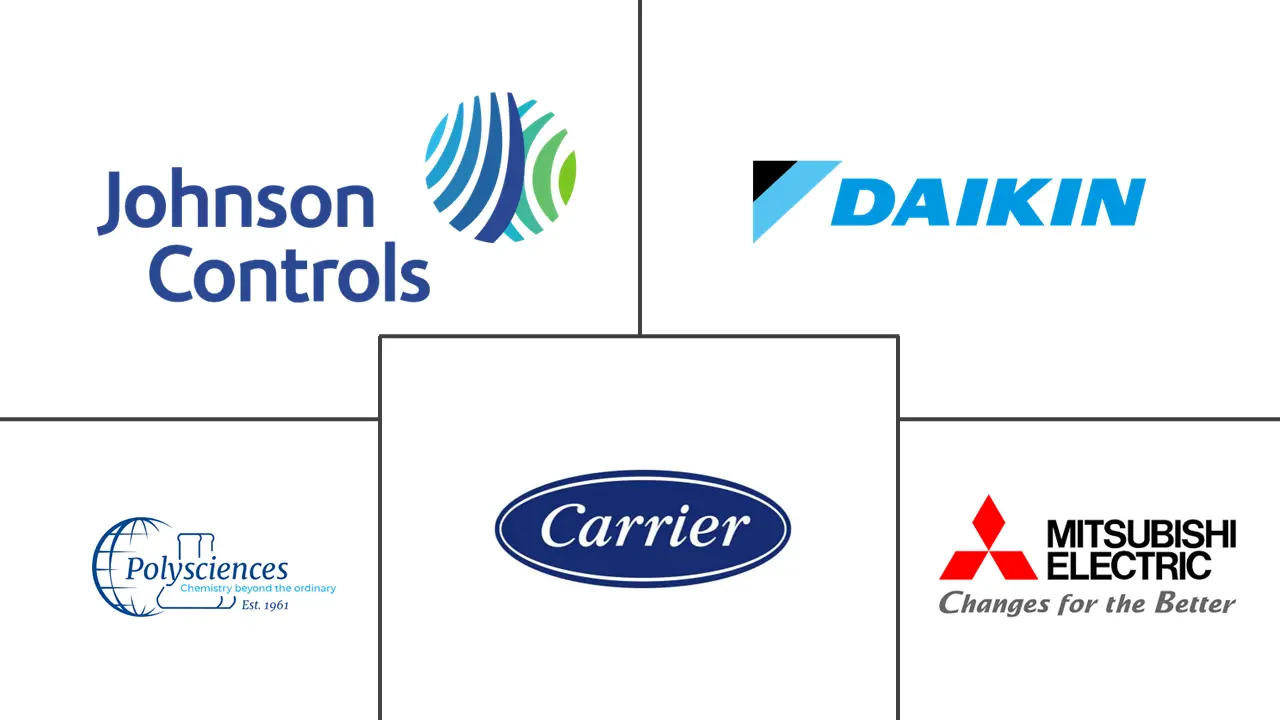Market Size of Chiller Industry

| Study Period | 2019 - 2029 |
| Base Year For Estimation | 2023 |
| CAGR | 4.20 % |
| Fastest Growing Market | North America |
| Largest Market | Asia-Pacific |
| Market Concentration | Medium |
Major Players
*Disclaimer: Major Players sorted in no particular order |
Chillers Market Analysis
The Global Chiller Market is expected to register a CAGR of 4.2% during the forecast period (2022-2027). The growth in construction of new commercial buildings, urbanization, and modernization of healthcare infrastructure is anticipated to drive the market's growth worldwide. Additionally, an increasing number of chemical plants, one of the biggest consumers of chiller systems, is anticipated to fuel demand for chiller systems during the forecast period.
- According Indian Brand Equity Foundation, by 2025, it is anticipated that investments in the Indian chemicals and petrochemicals sector will total INR 8 lakh crore (USD 107.38 billion). In December 2021, in India, the chemical output totaled 903,002 MT, while petrochemical production totaled 1,877,907 MT. The following chemicals were produced at a high level in December 2021: soda ash (257,199 MT), caustic soda (277,638 MT), liquid chlorine (190,492 MT), formaldehyde (22,794 MT), and pesticides and insecticides (22,110 MT).
- Additionally, with the approaching HFC (hydrofluorocarbon) phasedown, the demand for environmentally friendly cooling solutions is driving chiller manufacturers to innovate. To cater to this, in February 2022, Washington-based Pro-Refrigeration, Inc., a manufacturer and supplier of chillers for beverage processing and industrial markets, developed the idea of a CO2 chiller. Since CO2 is a natural refrigerant with a global warming potential (GWP) rating of 1, it has zero impact on global warming. It also allows refrigeration systems to recover 100% of the heat rejected from their systems, generating hot water at up to 200°F. Heat recovery capability is an essential product feature for Pro-Refrigeration, as beverage plants, dairy farms, use a high amount of natural gas or propane to heat water for sanitizing and wash-down.
- The increasing need for environment friendly and sustainable products is leading various manufacturers to develop sustainable products and solutions. For instance, in March 2021, Rhoss launched MiDIpack-I Eco, a new range of air-cooled water chillers and reversible heat pump products range with inverter scroll compressors and R32 ecological gas. The range was aimed at the companies that opt for eco-sustainability.
- On the flip side, environmental concerns regarding global warming and ozone depletion have led over time to the development of evolving global and regional regulations, which have had significant implications for refrigerants across applications. Manufacturers and end-users who purchase, design, install, and service air conditioning and refrigeration equipment should consult their specific country's current regulations, codes, and standards to aid with refrigerant selection for each intended use.
- The United Nations Environment Program - Division of Technology, Industry, and Economics (UNEP DTIE) OzonAction Branch assists countries in complying with their commitments under the Montreal Protocol on Substances that Deplete the Ozone Layer, especially those related to the phase-out of hydrochlorofluorocarbons (HCFCs). The substitutes to HCFCs include the climate and ozone-friendly alternatives such as natural refrigerants - ammonia, hydrocarbons, and carbon dioxide; and lower global warming potential (GWP) HFCs, both saturated HFCs and unsaturated HFCs (HFOs). These factors pose a challenge to the current market ecosystem. However, they also double as significant opportunity providers for several companies to adopt advanced technologies, nurture innovations and promote efficiency.
Chillers Industry Segmentation
A chiller is a machine that removes heat from a liquid coolant by vapor-compression, absorption refrigeration, or adsorption refrigeration cycles. Compressor, condenser, expansion valve, and evaporator are essential components of a chiller. They work in unison to circulate a refrigerant that removes heat from a process, operation, or space.
The Global Chiller Market is Segmented by Heat Rejection Method (Water Cooled, Air Cooled), Compressor Type (Screw Chillers, Scroll Chillers, Reciprocating Chillers, Centrifugal Chillers, Absorption Chiller), End-User Industry (Chemicals & Petrochemicals, Food & Beverage, Medical, Plastics), and Geography.
| By Heat Rejection Method or Type of Cooling | |
| Water Cooled | |
| Air Cooled |
| By Compressor Type | |
| Screw Chillers | |
| Scroll Chillers | |
| Reciprocating Chillers | |
| Centrifugal Chillers | |
| Absorption Chillers |
| By End-User Industry | |
| Chemicals & Petrochemicals | |
| Food & Beverage | |
| Medical | |
| Plastics | |
| Others |
| By Geography | |||||||
| |||||||
| |||||||
| |||||||
| |||||||
| Middle East & Africa |
Chiller Market Size Summary
The global chiller market is poised for steady growth, driven by factors such as urbanization, the construction of new commercial buildings, and the modernization of healthcare infrastructure. The demand for chiller systems is further bolstered by the increasing number of chemical plants, which are significant consumers of these systems. The market is also witnessing a shift towards environmentally friendly cooling solutions, spurred by the impending phasedown of hydrofluorocarbons (HFCs). Manufacturers are innovating to develop sustainable products, such as CO2 chillers and air-cooled water chillers using ecological gases, to meet the growing demand for eco-friendly solutions. This trend is supported by regulatory frameworks aimed at reducing global warming and ozone depletion, which encourage the adoption of natural refrigerants and lower global warming potential alternatives.
In North America, the chiller market is experiencing growth due to economic expansion, urbanization, and government support for infrastructure projects like smart cities and airports. The increasing construction of data centers, driven by the need for efficient cooling solutions, is also contributing to market expansion. Companies are introducing advanced products to cater to diverse customer needs, with a focus on energy efficiency and sustainability. The competitive landscape is marked by strategic partnerships and product developments among major players such as Carrier Global Corporation, Mitsubishi Electric Corporation, and Johnson Controls. These companies are leveraging innovations in refrigerant technology and energy-efficient designs to capture a larger market share, addressing the rising demand across residential, commercial, and industrial sectors.
Chiller Market Size - Table of Contents
-
1. MARKET INSIGHTS
-
1.1 Market Overview
-
1.2 Industry Attractiveness - Porter's Five Forces Analysis
-
1.2.1 Bargaining Power Of Suppliers
-
1.2.2 Bargaining Power Of Buyers
-
1.2.3 Threat Of New Entrants
-
1.2.4 Threat Of Substitutes
-
1.2.5 Intensity Of Competitive Rivalry
-
-
1.3 Value Chain Analysis
-
1.4 Assessment of the Impact of Covid-19 on the Market
-
-
2. MARKET SEGMENTATION
-
2.1 By Heat Rejection Method or Type of Cooling
-
2.1.1 Water Cooled
-
2.1.2 Air Cooled
-
-
2.2 By Compressor Type
-
2.2.1 Screw Chillers
-
2.2.2 Scroll Chillers
-
2.2.3 Reciprocating Chillers
-
2.2.4 Centrifugal Chillers
-
2.2.5 Absorption Chillers
-
-
2.3 By End-User Industry
-
2.3.1 Chemicals & Petrochemicals
-
2.3.2 Food & Beverage
-
2.3.3 Medical
-
2.3.4 Plastics
-
2.3.5 Others
-
-
2.4 By Geography
-
2.4.1 North America
-
2.4.1.1 United States
-
2.4.1.2 Canada
-
-
2.4.2 Europe
-
2.4.2.1 United Kingdm
-
2.4.2.2 Germany
-
2.4.2.3 France
-
2.4.2.4 Rest of Europe
-
-
2.4.3 Asia Pacific
-
2.4.3.1 China
-
2.4.3.2 Japan
-
2.4.3.3 India
-
2.4.3.4 South Korea
-
2.4.3.5 Rest of Asia Pacific
-
-
2.4.4 Latin America
-
2.4.4.1 Brazil
-
2.4.4.2 Mexico
-
2.4.4.3 Rest of Latin America
-
-
2.4.5 Middle East & Africa
-
-
Chiller Market Size FAQs
What is the current Chiller Market size?
The Chiller Market is projected to register a CAGR of 4.20% during the forecast period (2024-2029)
Who are the key players in Chiller Market?
Carrier Global Corporation, DAIKIN INDUSTRIES LTD, Johnson Controls International, Mitsubishi Electric Corporation and Polyscience Inc. are the major companies operating in the Chiller Market.

